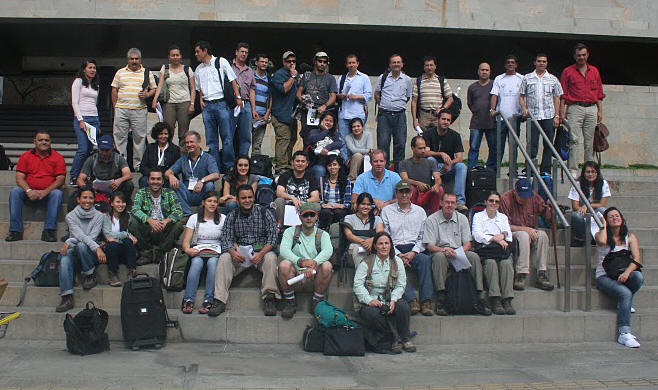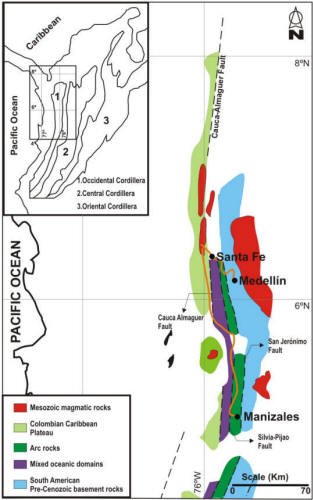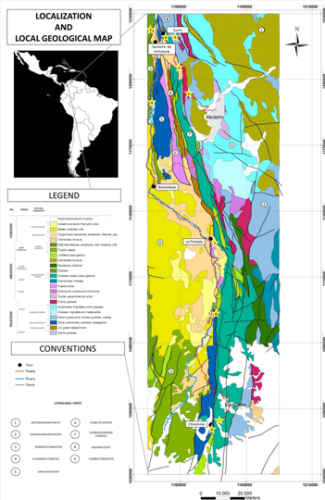The 3-day fieldtrip will guide us through the various elements that formed
the current western South American margin. These include:
James Pindell (Tectonic Analysis,
UK; jim@tectonicanalysis.com)
Antonio Garcia Casco (University of Granada, Spain;
agcasco@ugr.es)
Uwe Martens (Tectonic Analysis,
USA; umartens@zoho.com)
Carl Nelson (Recursos del Caribe, USA,
CNelson945@aol.com)
Carmen Nelson
Walter.V. Maresch (Ruhr-Universitaet
Bochum, Germany, walter.maresch@rub.de)
Agustin Cardona (Smithsonian
Tropical Research Institute, Panama,
cardonaa@si.edu)
Juan Carlos Silva (Smithsonian
Tropical Research Institute;
jsilvatamayo@yahoo.com)
Marion Weber (Universidad Nacional de Colombia, Sede
de Medellín,
mweber@unalmed.edu.co)
Andres Pardo (Universidad de Caldas;
andres.pardo@ucaldas.edu.co)
Jose Vicente Rodriguez
Jorge Restrepo (Universidad Nacional de Colombia, Sede
de Medellín,
jjrestrepoa@fastmail.fm)
Andres Bustamante (Universidade de Sao Paulo IG-USP,
BRASIL; andresbl@aim.com)
Mónica Janeth Tobón (BHP Billiton, Cerro Matoso S.A,
Monica.M.Tobon@bhpbilliton.com)
Francisco Velandia (Universidad Industrial de
Santander, favelanp@uis.edu.co)
Gustavo Sarmiento (Universidad Nacional de Colombia,
sede Bogotá,
gasarmientop@gmail.com)
Carlos Zuluaga (Universidad Nacional de Colombia, sede
Bogotá,
cazuluagacas@unal.edu.co)
Andreas Kammer (Universidad Nacional de Colombia, sede
Bogotá, kammer.andreas@gmail.com)
Victor Valencia (Universidad de Arizona,
vicvalencia1@gmail.com)
John Lewis (George Washington
University, jlewis@gwu.edu,
Jfkdlewis@aol.com)
Gloria Sierra (Universidad Eafit,
gsierra@eafit.edu.co)
Gabriel Rodriguez
(grodrig@ingeominas.gov.co)
Wilson Enario Naranjo Merchan (UPTC- Sogamoso,
wilson.naranjo@uptc.edu.co)
Cesar Vinasco (Universidad Nacional de Colombia, Sede
de Medellín, cvinasco@unal.edu.co)
Sebastian Zapata (STRI, Panama,
szapatah@gmail.com)
Students
Eliana Mejia Toro (Universidad Nacional de Colombia,
sede Bogotá,
elianamejiatoro@gmail.com)
Alejandra Alvarez (alejandra.alvarez212@gmail.com)
Jose Duque (Msc Estudiante UNAM, Mexico;
jduquetr@gmail.com)
Yohana Villafañez Cardona (yohanavicar@gmail.com)
Lina Serrano (Universita di Padova;
linaserranod@hotmail.com)
Jakeline Vanegas Arroyave (Est. Universidad Nacional
de Colombia, sede Medellín,
jvanegaa@gmail.com)
Samuel Jaramilo (sam.jaramillo.gi@hotmail.com)
Mario Lara (Universidad Nacional de Colombia, sede
Medellín,
marioelarao@hotmail.com)
Natalia Acevedo Gomez (Universidad Nacional de
Colombia, Sede Medellín,
naceved@unal.edu.co)
Maria Fernanda Areiza (Universidad Nacional de
Colombia, Sede Medellín,
mfareiza@unal.edu.co)
Andrea Lotero (Universidad Nacional de Colombia, sede
Medellín,
andrea.loterovelez@gmail.com)
Carolina Echeverry (carolaina22@gmail.com)
Sandra Mendez (scmendeze@gmail.com)

The participants (3 Sept, 2011).
![]() Medellín, Colombia 29 August - 2 September, 2011. XIV Latin-American Geological
and XIII Colombian Geological Congresses.
Special Session "Crustal growth and modification at the Caribbean plate margins"
and associated Field Trip "Geological transect through the evolution of an
accretionary margin"
Medellín, Colombia 29 August - 2 September, 2011. XIV Latin-American Geological
and XIII Colombian Geological Congresses.
Special Session "Crustal growth and modification at the Caribbean plate margins"
and associated Field Trip "Geological transect through the evolution of an
accretionary margin"
